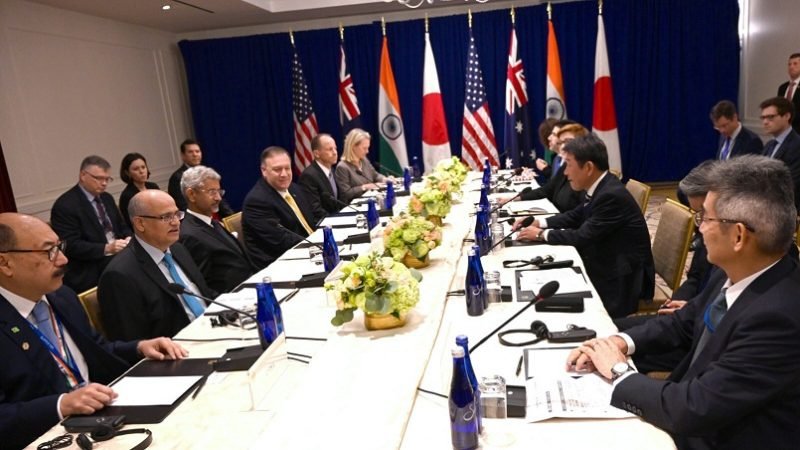Quad Grouping and India’s role in it

Abstract
With the emergence of china economically, the geopolitics of the Indo-Pacific region is in the centre of attraction. China on one hand is not only trying to enhance its influence but also trying to change the status quo of the region with all the means possible. On the other hand, the regional power like India, Australia and Japan along with the superpower like the USA is seeing themselves at the receiving end. This common interest against the same adversary brought four democracy together as ‘Quad’ formally known as quadrilateral security dialogue. This article analyses the condition and circumstances which brought these nations together. What are the possible challenges before these nations? And finally what is India’s role in the grouping?
The emergence of ‘QUAD 1.0’

The grouping of the four democracies India, Australia, Japan and the USA known as Quadrilateral Security dialogue or ‘Quad’. The story of ‘Quad’ is gradual convergence and is not of rapid institutionalization. It was initiated by the Japanese PM Shinzo Abe in the year 2007, his ‘confluence of two seas’ speech provides the foundation for grouping. However, the root of the grouping can be traced back to 2004 when these nation form ‘core group’, which is a joint response to Boxing Day Tsunami. This gains momentum only after PM Shinzo Abe proposal to form ‘Arc of freedom and Prosperity’ which means joining the nation having a common interest in 2006. The USA who has started using the Asia-Pacific region as the Indo-pacific region clearly indicates the changed interest in the region. Ironically, the formation of this group is still informal and there is no concrete formal grouping as such beside the common interest of all the four participating nation. According to the survey conducted by CSIS (Centre for strategic and international studies), all four countries are more inclined toward posturing ‘Quad’ role as coordinating regional economic and development assistant and less enthusiast about proposing military task force and ‘Quad’ secretariat. The first meeting of initial ‘Quad’ happens at ASEAN regional forum in Manila. This meeting is termed as ‘informal’ and touched upon the area of mutual interest in the Indo-Pacific region. The second ‘Malabar’ naval exercise of 2007 in which the navy of four countries along with Singapore navy took part in Bay of Bengal region of Indian Ocean is turned out to be the final act for initiating ‘Quad’.
Due to the lack of specificity about the grouping, it is seen as the attempt to contain China. Many scholars pointed out that soon this group will turn into an ‘Asian-NATO’. On the one hand, China is putting diplomatic and economic pressure against any such grouping and on the other hand, countries like South Korea and Vietnam tries to distance itself from the grouping sensing anti-China sentiment. They are in no mood to antagonize China. Australia succumbed to the pressure and decided to opt-out of ‘Quad Dialogue’ scheduled for January 2008. Also, India’s huge dependence on Russia for its defence equipment and India’s foreign policy of Non-Alignment is the blocking stone for addressing common interest in the region. This lead to the failure of the ‘Quad 1.0’, as every participating nation do not find themselves on the same page against the common adversary.

Rebirth of the group as ‘QUAD 2.0’
To counter China’s aggressive and assertive behaviour in the Indo-Pacific region; India, Australia, Japan and the USA again formed the ‘quadrilateral’ coalition in November 2017. The first meeting was held a day before the ASEAN summit. The foreign ministers from all the nations meet at Manila to discuss the common interest and changed perspective in the Indo-Pacific region. Today’s progress is the hard-fought result of Intra-quad diplomacy and convergence of common threat narrative. After the collapse of ‘Quad 1.0’, the year of bilateral and trilateral diplomacy shaped the agenda for ‘Quad 2.0’. An initiative like bilateral 2+2 dialogue, signing of mutual agreement like LEMOA (Logistics exchange memorandum of agreement), COMCASA (Communication, compatibility and security agreement), and CISMOA (Communication and information security memorandum of agreement) between India and the USA, Inclusion of Japan into various military exercises like ‘Malabar’, Pitch Black, Talisman Saber etc and breaking the hurdle by signing India-Japan Nuclear deal laid the basic foundation and keep the mutual interest of all the nation floating.
Further, China’s growing assertiveness, accenting military power, bullying tactics and increasing global footprint glued the national interests of four nations together. The resurgence of ‘Quad’ in 2017, clearly indicate the changing geopolitics, especially, in the Indo-Pacific region. However, the situation of ‘Quad 2.0’ is still that of informal dialogue. The ‘Quad’ has met biannual basis since 2017 and the exclusion of Australia from the ‘Malabar’ naval exercise is still an exasperating event.

How shall India view ‘QUAD?’
There have always been ups and downs since the inception of ‘Quad’ in 2007. India, which is facing twin challenges from China, one, at the long LAC, where china has compromised India’s sovereignty through its ambitious CPEC and second, encircling India in the Indian Ocean region by its policy of ‘string of pearl’. Further continuous skirmish and standoff at long LAC have become the order of the day. India which is the most affected and also, the weakest link among the ‘Quad’ member, finds itself at the junction to go for any military alliance with the country already bind by military understanding. First, formally establishing ‘Quad’ as a military block to contain China will go against India’s policy of non-alignment. Second, joining military block with the USA undermine India’s interest in Central Asia, where Russia is the key defence partner.
Further, there is also, the possibility of concrete China-Pakistan-Russia nexus to counter Washington-led alliance in the Indian Ocean region and not to forget of joining unpredictable North Korea with the nexus. The New Delhi has still relied heavily on Russia for military logistic and spear part. Defense Minister, Rajnath Singh’s visit to Moscow amid border tension shows the importance of the Russian support for India. It is becoming very difficult for New Delhi to balance between the China lead SCO (Shanghai corporation organization) and the American-led ‘Quad’. That is why PM Modi in his opening address to Shangri-La dialogue advocated for peaceful and stable Indo-Pacific region but did not mention China’s military expansion in the region and growing assertiveness in the South China Sea. This confusion of New Delhi forces the USA to keep an adequate distance from committing any security pact. However, situation after COVID-19 Pandemic and border standoff at Galwan valley, where, Indian side lost 20 of its soldier, has changed a lot. New Delhi is exerting more aggressive instance against Beijing since the Galwan standoff. From giving vocal for the local call under ‘Atmanirbhar Bharat’ to banning 59 Chinese apps.

What if ‘QUAD’ became Asian-NATO?
Though the future of ‘Quad’ is still not clear and a great deal needs to happen before any concrete claims. It cannot be denied that like ‘Quad 1.0’ the internal politics of the member countries can again lead to the failure of ‘Quad 2.0’ failure. Also, the failure of cold war military-like SEATO, CENTO and ANZUS in the South and South-East Asia has much to do with a lack of confidence among the member countries. However, the way in which the world order is shaping, aggressiveness with which China is trying to project it as an Asian giant and the manner in which China is trying to change status quo along with nibbling territories of the neighbouring countries.
The projection of ‘Quad’ becoming an Asian –NATO is not far. This will not only trigger the arms race but can also lead to a new cold war in the world with China as the new pole. All the key ‘Quad’ countries along with the non-quad countries need to establish the working level contact to keep the trade and navigation secure throughout the Indo-Pacific region. Since Quad is the grouping of four democracies consisting of the oldest and the largest democracy. It needs to take the interest and scope of littoral countries into consideration before projecting itself as the military alliance. Further ‘Quad’ as a military alliance, has far-reaching consequences than immediate relief. We can get the gist of the region by just looking at nuclear arsenal pileup in the region. Almost 6 countries possessing nuclear weapon lies in the Indo-Pacific (including North Korea) and even a small trigger can have grave consequences for peace and stability of the region.
Conclusion
French Military leader and Emperor Napoleon Bonaparte called china a sleeping giant 200 years ago. Some scholar while interpreting Emperor Napoleon argued that ‘China will shock the world when it will wake up’. The words of Emperor 200 year ago is turning out to be true. Today, china is second-largest economic power and is the largest manufacturing hub in the world. It is almost self-reliant in every sector and now challenging the US hegemony in the world. In doing so it is trying to undermine the interest of the regional power like Japan, Australia and India. Since, these countries are facing a direct impact of China’s rise, as their sovereignty and national security are at stake.
The concept of ‘collective security’ forwarded by a scholar like Immanuel Kant is deemed to apply in this scenario. It is natural for all like-minded countries (here democracies as well) to discuss regional peace and security. The US secretary of state, Mike Pompeo, while addressing in Washington DC stated that ‘The ‘Quad’ will prove very important in the efforts, ahead ensuring that China retains only its proper place in the world’. The grouping like ‘Quad’ is befitting reply to China’s hegemonic regional aspiration. However, ‘Quad’ member need to utilize the platform for engaging the participant in a much wider field than just containing china. The ‘Quad’ can engage itself into securing navigation, reducing terrorism and managing the balance of power in the region. November 2017, Quad’s counter-terrorism exercise was the first step in this direction. India lying on the junction and sharing the longest physical boundary among member countries in ‘Quad’ need to choose wisely and with perfection.


















